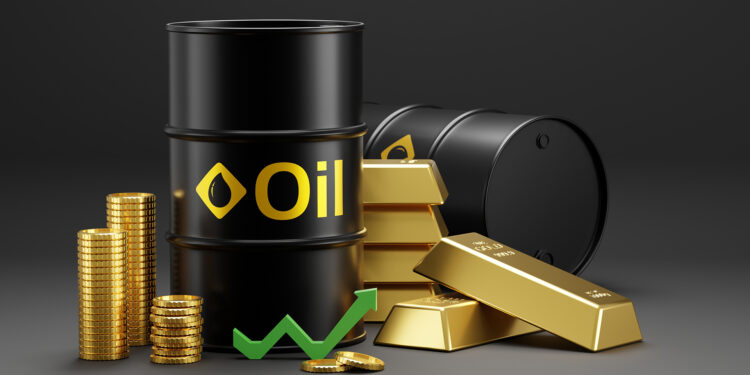Gold prices increased during trading today, Wednesday, driven by imminent risks from US President-elect Donald Trump’s intention to impose new customs duties. The dollar also rose thanks to US data, and the contraction of Russian supplies pushed oil to rise.
gold
Gold prices rose today, Wednesday, thanks to the imminent risks resulting from US President-elect Donald Trump’s intention to impose new customs duties, while investors await more economic data to anticipate the position of the Federal Reserve (the US central bank) on interest rates this year.
The price of gold in spot transactions rose 0.07% to $2,650.45 per ounce, in the latest trading, and US gold futures contracts fell 0.05% to $2,664.2.
The head of commodity strategy at Saxo Bank, Ole Hansen, said that the risk of Trump igniting a trade war, the continuation of inflation, and fears about financial stability with the rise in US Treasury bond yields represent current and future factors that may enhance risks, which will be supportive of gold.
Trump is scheduled to be sworn in as President of the United States on January 20, and the tariffs and trade protectionist policies he proposes are expected to increase inflation and may spark trade wars, which increases the attractiveness of gold as a safe haven.
Gold is also used as a hedge against inflation, but high interest rates reduce the attractiveness of holding the non-yielding yellow metal.
The market is awaiting ADP employment data and the minutes of the Federal Reserve’s December meeting, both released later today, along with the US non-farm payrolls report scheduled for Friday, which may provide further… An indicator of the direction of US monetary policy.
Data yesterday, Tuesday, showed an increase in job opportunities in the United States in November, while the employment rate declined, indicating a slowdown in the labor market at a pace that may not require the Federal Reserve to rush to reduce interest rates.
After the US Central Bank reduced interest rates three times in 2024, it expected in December to reduce interest rates only twice in 2025, and the markets currently expect it to be reduced by 38 basis points this year.
In terms of other precious metals, silver rose in spot transactions 0.2% to $30.09 per ounce, platinum increased 0.53% to $954.64, and palladium stabilized at $931.12.
Dollar
The dollar rose today and the yen fell, approaching levels that required intervention by the Japanese authorities last year, after strong data in the United States pushed US Treasury bond yields to rise and reduced bets on lowering interest rates, as there is an inverse proportionality.
The Japanese currency against the dollar approached the level of 158.42 yen overnight, which is the weakest level in about 6 months, while in the latest trading it reached 158.45 yen.
Yesterday, the Japanese Finance Minister warned against selling the yen in a hasty manner, with the exchange rate approaching the 160 level, which led to selling operations 6 months ago.
“It’s an important resistance level… very strong US numbers are coming in,” said Bart Wakabayashi, Tokyo Branch Manager at State Street, which supports expectations of the US Reserve cutting interest rates until the summer or later.
He continued: “There is also a discussion about whether they will lower interest rates or perhaps raise them? The conversation has changed significantly, which should lead… to more strength in the dollar.”
The euro fell by about 0.5% overnight and was trading at about $1.0351 in Asian trading. The British pound also fell to $1.2478, and the yuan reached its lowest level in 6 months at 7.3319 against the dollar.
Traders are concerned ahead of US labor data scheduled to be released on Friday, as well as President-elect Donald Trump’s return to the White House on January 20.
Data yesterday, Tuesday, showed an unexpected increase in job opportunities in the United States in November and a decrease in layoffs, while service sector activity accelerated in December.
Oil
Oil prices rose today with shrinking supplies from Russia and OPEC members, while data showing an unexpected increase in job opportunities in the United States indicated an expansion of economic activity and subsequent growth in demand for oil.
Brent crude rose 27 cents, or 0.27%, to $77.27 a barrel, in the latest trading, and US West Texas Intermediate crude rose 35 cents, or 0.47%, to $74.6.
A Reuters survey showed that OPEC oil production fell in December after a two-month increase, and field maintenance work in the UAE offset the increased production of Nigeria and other countries in the group.
In Russia, oil production averaged 8.971 million barrels per day in December, below Moscow’s target, according to Bloomberg.
The Job Opportunities and Labor Turnover Survey showed that job openings in the United States rose in November, while the number of layoffs decreased and workers were reluctant to quit.
DIG analyst Yip Jun Rong said: “Strong US economic data continues to strengthen the outlook for the US economy and demand for oil, and this is also supported by a larger-than-expected decline in crude inventories.”
Market sources, citing data from the American Petroleum Institute, said yesterday, Tuesday, that crude oil inventories decreased last week, while fuel inventories rose.
Going forward, analysts expect oil prices to fall on average this year compared to 2024 due to production increases from non-OPEC countries.
“We are sticking to our expectations that the price of Brent crude oil will average $76 per barrel in 2025, down from an average of $80 per barrel in 2024,” Fitch’s BMI said in a note to clients.
She added: “The reduction in expectations is led by our data estimates, which indicate a surplus in supply during the current year, with supply growth exceeding demand growth by 485 thousand barrels per day.”



